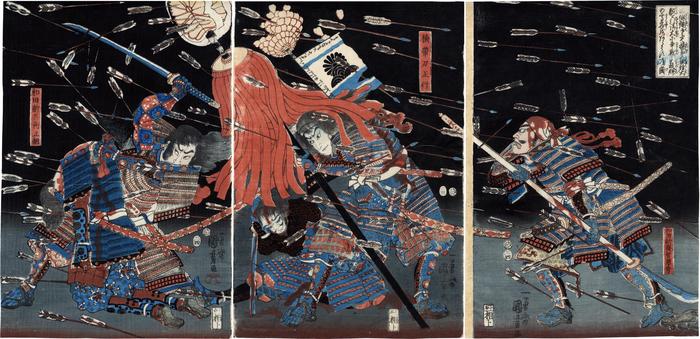Utagawa Kuniyoshi (歌川国芳) (artist 11/15/1797 – 03/05/1861)
The last stand of the Kusunoki at Shijō-nawate - 楠家勇士四条縄手にて討死
04/1857
28.5 in x 14 in (Overall dimensions) Japanese color woodblock prints
Signed: Ichiyūsai Kuniyoshi ga
一勇斎国芳画
Publisher: Sagamiya Tōkichi (Marks 435 - seal 24-009)
Date seal: 4/1857
Censor's seal: aratame
Museum of Fine Arts, Boston
Rijksmuseum
National Diet Library - go to #70
Google maps - location of Shijōnawate Shrine
Shijōnawate Shrine web page with good information about Kusunoki
The Wellcome Collection - the two left panels
Lyon Collection - the other triptych of this battle by Kuniyoshi published four months later
The Achenbach Foundation - the left-hand panel only This triptych is the right set of a double triptych dealing with the defeat of the Kusunoki family. - Kusunoki Masatsura (1326-48) continued his father's (Kusunoki Masahige, 1294-1336) struggle against the Ashikaga forces. Like his father he too failed, but in an equally glorious manner. He is shown in this triptych together with relatives and trusted retainers during the final stages of the battle of Shijōnawate on 4 February 1348.
See Schaap's Heroes & Ghosts, page 86, no. 65. [This triptych was said to have been published four months before its mate, Lyon Collection #349.]
****
"For a better understanding of the scene in this impressive double triptych it is necessary to look at he figure of Kusunoki Masashige (1294-1336). Masashige is unwavering in his support of emperor Go-Daigo (1288-1339) during his hopeless struggle to regain imperial authority and to dissolve the power of the military establishment. Masashige was a wonderfully gifted tactician and he is victorious on a number of occasions. The tide turns, however, when Masashige is decisively beaten at Minatogawa on 5 July, 1336 by the forces of the later shogun Ashikaga Takauji (1305-58). Before going to war Masashige takes leave of his son, Masatsura, knowing he would never survive the upcoming battle. Masashige subsequently becomes one of the most famous of all Japanese medieval heroes, second only to Minamoto Yoshitsune (1159-89), and in Ivan Morris' words: 'His (Masashige's) career most perfectly exemplified the Japanese heroic parabola: wholehearted effort on behalf of a hopeless cause leading to initial achievement and success but ending in glorious failure and brave, poignant death'..." Ibid.
****
The text in the cartouche in the upper right reads: 四条縄手にて楠家の英雄大敵を引請けて大いに争戦して抜群の高名をあらはすの図.
The full title as related by the Museum of Fine Arts in Boston is: "At Shijō-nawate, the Heroes of the Kusunoki Clan Take on a Gigantic Enemy Force and in a Mighty Battle Display Their Incomparable Renown (Shijō-nawate ni te Nanke no eiyū taiteki o hikiukete ōi ni sōsen shite batsugun no kōmyō o arawasu no zu)."
****
If you look closely at the black and white banner in the center panel you will notice that it is a chrysanthemum over roiling water. This is a variation on the Kusunoki family crest bestowed on them by the Emperor Go Daigo. In O-umajirushi: A 17th-Century Compendium of Samurai Heraldry (p. xxviii):
"An example of a mon story focused on human sources of prestige is that of Kusunoki Masashige. His brilliant defense of strongholds loyal to Emperor Go-Daigo was instrumental in restoring the emperor briefly to power in the Kenmu Restoration (1333-1336). Go-Daigo recognized Masashige by granting him a mon based on the normally-restricted imperial chrysanthemum, showing it supported by water. Go-Daigo explained that Masashige, in the same way, had kept him afloat by his support.
Unfortunately for them, one of Go-Daigo's key generals, Ashikaga Takauji, betrayed the emperor to seize rule over Japan for himself. Masashige knew that his forces in the capital were hopelessly outmatched and suggested that Go-Daigo retreat and regroup; however, Go-Daigo refused. Masashige then went into battle, knowing he was doomed, and willingly died for his emperor. Thus, he is remembered as a paragon of samurai loyalty."
****
Illustrated:
1) in a black and white reproduction in Catalogue of the Collection of Japanese Prints Part V - The Age of Yoshitoshi, Rijksprentkabinet/Rijksmuseum, 1990, no. 164, p. 165.
2) in color in Heroes & Ghosts by Robert Schaap, Hotei Publishing, 1998, page 86, no. 65.
Sagamiya Tōkichi (相模屋藤吉) (publisher)
warrior prints (musha-e - 武者絵) (genre)
